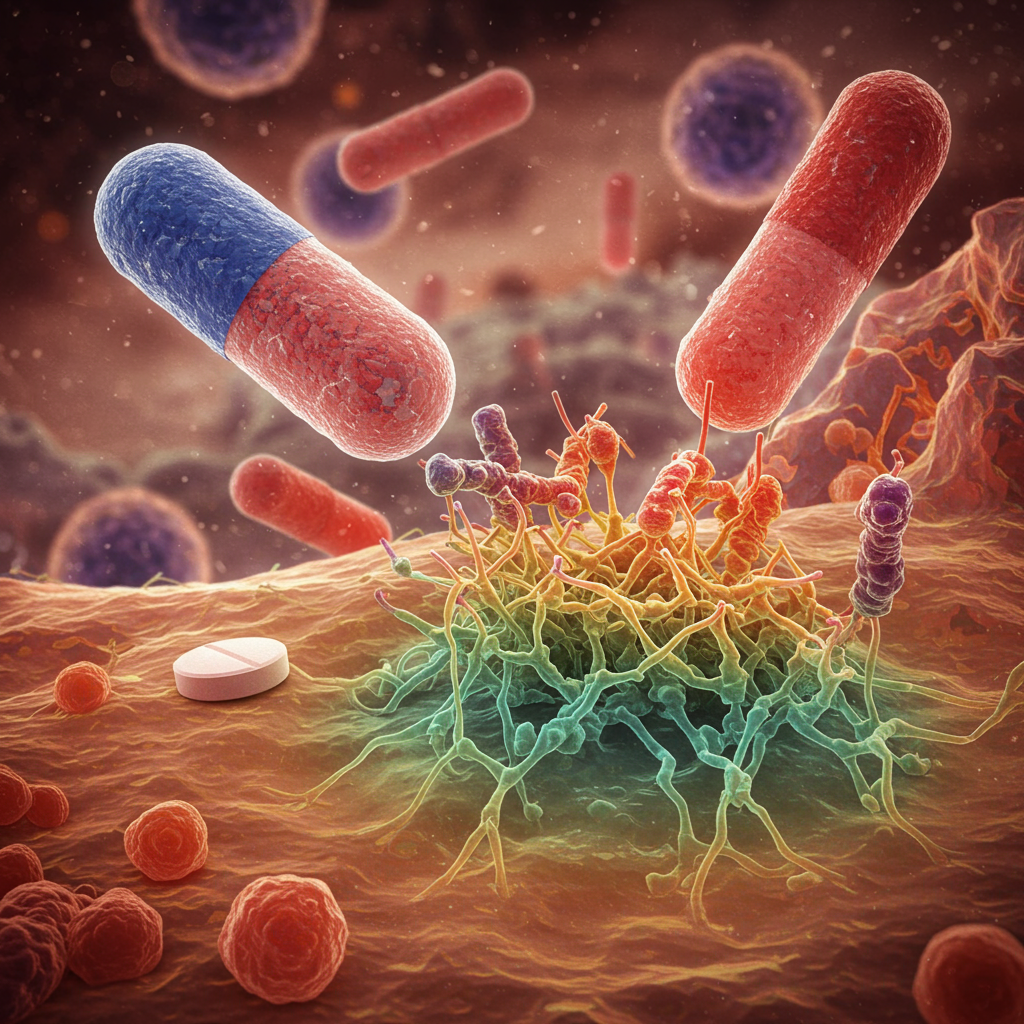The silent threat of antibiotic resistance just got louder. A groundbreaking new study reveals that common over-the-counter painkillers, including ibuprofen and acetaminophen, may inadvertently be fueling the very superbugs we desperately fight. This isn’t just a minor concern. It’s a critical new dimension to one of the world’s most urgent public health crises. Experts now warn that the impact of these everyday medications on antimicrobial resistance (AMR) could be far more profound than previously understood.
The Unexpected Link: Painkillers and Bacterial Mutations
For years, the focus on antibiotic resistance primarily centered on the misuse and overuse of antibiotics themselves. However, recent research from the University of South Australia has uncovered a startling connection. Lab tests investigated how two ubiquitous pain relievers, ibuprofen (often sold as Advil) and acetaminophen (known as Tylenol or paracetamol), interact with bacteria.
The study exposed E. coli, a common bacterium, to ciprofloxacin. Ciprofloxacin is a frequently prescribed antibiotic for infections like urinary tract infections. Researchers observed a significant and concerning trend. When E. coli was exposed to ciprofloxacin alongside either ibuprofen or paracetamol, the bacteria developed increased genetic mutations. Crucially, this effect was amplified when both painkillers were present simultaneously. These mutations transformed the bacteria, making them highly resistant not only to ciprofloxacin but to other classes of antibiotics too.
Associate Professor Rietie Venter, the study’s lead author, highlighted the broader implications. She stated that “Antibiotic resistance isn’t just about antibiotics anymore.” This underscores a critical shift in understanding. Medications beyond traditional antibiotics can play a role in this escalating crisis. Previous studies had already hinted at similar effects from other non-antibiotic drugs, including certain NSAIDs and antidepressants. The cumulative impact demands immediate attention.
How Pain Relievers Drive Resistance
The mechanism behind this unexpected finding is rooted in bacterial adaptation. When bacteria like E. coli encounter stress, such as exposure to antibiotics, they can undergo genetic changes. These mutations help them survive. The presence of common painkillers, the study suggests, somehow intensifies this mutational process. This effectively accelerates the bacteria’s ability to develop defenses against antibiotics. It’s like adding fuel to a fire, making these bacteria even harder to kill. This accelerated evolution creates tougher, drug-resistant superbugs.
This discovery doesn’t mean these painkillers are directly creating new superbugs. Instead, they appear to be supercharging the existing bacteria’s ability to resist the drugs we use to fight them. This is a concerning development for global health. It adds a complex layer to the ongoing battle against AMR.
A Public Health Crisis Rivaling Climate Change
The World Health Organization (WHO) consistently ranks antimicrobial resistance as one of the top global public health threats. The statistics are stark. In 2019 alone, drug-resistant bacteria were directly responsible for 1.27 million deaths worldwide. They were associated with nearly five million deaths overall. Projections paint an even grimmer picture. If current trends continue unchecked, AMR-related fatalities could skyrocket to nearly 40 million over the next 25 years. This is a staggering human cost.
Professor Dame Sally Davies, former chief medical officer for England and the UK’s special envoy on AMR, offers a chilling perspective. She warns that the global threat of drug-resistant superbugs could make the COVID-19 pandemic “look minor.” Davies argues that AMR is “more acute” than climate change itself. She predicts a bleak future if we fail to tackle this problem within the next decade. Unlike viral pandemics that may eventually fade, AMR is a persistent threat. It will “grind on for decades” if left unaddressed.
The Far-Reaching Consequences of Unchecked AMR
The implications of widespread antibiotic failure are profound. If infections become untreatable, much of modern medicine would become too risky. Vital procedures like caesarean sections, cancer treatments, and organ transplants rely heavily on effective antibiotics. They prevent post-operative infections. Without them, these life-saving interventions could become exceptionally dangerous. Patients with untreatable infections might require isolation. This would prevent further spread within healthcare facilities and communities.
This crisis also carries a heavy burden of inequity. One in five AMR deaths occurs in children under five. Most of these deaths happen in sub-Saharan Africa. The problem there is “particularly prevalent and disastrous.” Dame Sally Davies also highlights a worrying link to the climate crisis. Climate change events like floods, droughts, and mass displacement can contribute to infection spread. This, in turn, exacerbates the antimicrobial resistance problem. Davies contends that AMR will likely kill more people before climate change does.
Beyond the Medicine Cabinet: Hidden Drivers of Resistance
The problem of AMR extends far beyond just human medicine. A significant driver is the extensive use of antibiotics in agriculture. More than two-thirds of all antibiotics are administered to farm animals. This often happens to promote growth or prevent infections in unsanitary, overcrowded conditions. It’s not always for the therapeutic treatment of specific diseases. For example, fish farms in Asia sometimes add antibiotics to feed. This is often due to cost-effectiveness or a lack of research into alternative treatments. This widespread use creates massive reservoirs for resistance.
Furthermore, both animals and humans excrete a large portion of consumed antibiotics. Up to 80% can contaminate water systems and the environment. This problem is compounded by antibiotic manufacturing facilities. These facilities may release “dramatic amounts” of these powerful drugs into waterways. These environmental pathways further spread resistance genes. This creates a complex web of factors contributing to the rise of drug-resistant infections.
A particularly vulnerable setting is elder care facilities. Residents there often receive multiple medications (polypharmacy). Combinations of painkillers, sleeping aids, decongestants, and other drugs are common. Many of these medications were included in the University of South Australia study. In such environments, the risk of resistant superbugs emerging and spreading is significantly heightened. Healthcare providers must re-examine medication schedules. Safer alternatives or more strategic combinations should be considered.
Navigating Forward: Solutions and Responsible Use
Given these concerning findings, what should individuals and healthcare providers do? The researchers are clear: this doesn’t mean people should abruptly stop using these medications. Instead, the message is to be more mindful. We need to understand how painkillers interact with antibiotics. This includes looking beyond just two-drug combinations.
On a broader scale, global efforts are underway. The UK government, for instance, has launched a national action plan on AMR. This plan aims to reduce antimicrobial use in humans and animals. It also seeks to strengthen surveillance and incentivize the development of new drugs and vaccines. The COVID-19 pandemic temporarily stalled some progress. However, there are success stories. A major U.S. poultry supplier, for example, has successfully discontinued antibiotic use.
Technological advancements offer significant promise. Genomics and artificial intelligence are “reinvigorating” antibiotic research. They offer new avenues for understanding and combating resistance. Developing new antibiotics is economically challenging. Ideally, these new drugs should be reserved as last-resort treatments. This limits sales and return on investment. To address this, countries are exploring innovative funding models. NHS England is experimenting with a subscription model. It pays a fixed annual fee for access to antimicrobials, irrespective of usage volume.
The UN Global Leaders Group on AMR is pushing for ambitious targets by 2030. These include reducing global human deaths from AMR by 10%. They also aim to cut antimicrobial use in agriculture by at least 30%. Ending the non-therapeutic use of “medically important antimicrobials” in farming is another key goal. More formal international governance structures are advocated. These could be similar to climate change summits. An independent scientific panel, like the IPCC, could also help ensure global collaboration.
Practical Steps for Individuals
While researchers and policymakers work on systemic solutions, individuals can also play a role:
Discuss Medications: Always inform your doctor or pharmacist about all medications, including over-the-counter painkillers and supplements, when you are prescribed an antibiotic.
Responsible Antibiotic Use: Only take antibiotics when prescribed by a healthcare professional. Complete the full course, even if you feel better.
Prevent Infections: Practice good hygiene, get recommended vaccinations, and prepare food safely to reduce the need for antibiotics.
Question Over-Prescribing: Don’t pressure your doctor for antibiotics if they say it’s not necessary (e.g., for viral infections like the common cold).
Frequently Asked Questions
What exactly is the link between common painkillers and antibiotic resistance?
A recent University of South Australia study found that common painkillers like ibuprofen and acetaminophen (paracetamol) can increase genetic mutations in bacteria like E. coli when exposed to antibiotics. These mutations make the bacteria more resistant to the antibiotic. The effect is particularly strong when both painkillers are used together. This mechanism essentially accelerates the development of drug-resistant infections, contributing to the superbug problem.
Should I stop taking ibuprofen or acetaminophen if I’m on antibiotics?
No, researchers do not advise people to stop using these medications. Instead, the recommendation is to be more mindful of how painkillers interact with antibiotics. It’s crucial to discuss all medications, including over-the-counter ones, with your doctor or pharmacist when you are prescribed an antibiotic. This allows healthcare providers, especially in high-risk settings like elder care, to re-examine medication schedules and consider safer alternatives if needed. Always follow your doctor’s advice.
How significant is the global threat of antimicrobial resistance (AMR)?
The World Health Organization designates AMR as one of the top global public health threats. In 2019, drug-resistant bacteria directly caused 1.27 million deaths and were associated with nearly five million deaths globally. Experts like Professor Dame Sally Davies warn that AMR could make the COVID-19 pandemic “look minor” and is “more acute” than climate change. If unchecked, AMR could lead to nearly 40 million deaths over the next 25 years, making many modern medical procedures too risky.
Conclusion
The connection between common painkillers and accelerated antibiotic resistance adds an unexpected layer to a global health crisis that is already alarming. The rise of superbugs poses an existential threat to modern medicine. It demands a holistic approach, looking beyond just antibiotics to understand all factors that drive resistance. From the responsible use of medication in our homes to agricultural practices and global policy, every action counts. By understanding these new findings and taking proactive steps, we can collectively work to safeguard the effectiveness of our life-saving antibiotics for generations to come.




